Affiliate disclosure: This post may contain affiliate links. Please see our Privacy Policy.
Freeze-dried milk is different than regular dried milk powder, and it tastes infinitely better. When rehydrated, freeze-dried milk tastes exactly like regular milk, and it’ll store right on the pantry shelf for a decade or more, until you need it.
Learn how to freeze dry milk at home, as well as ways to use it.
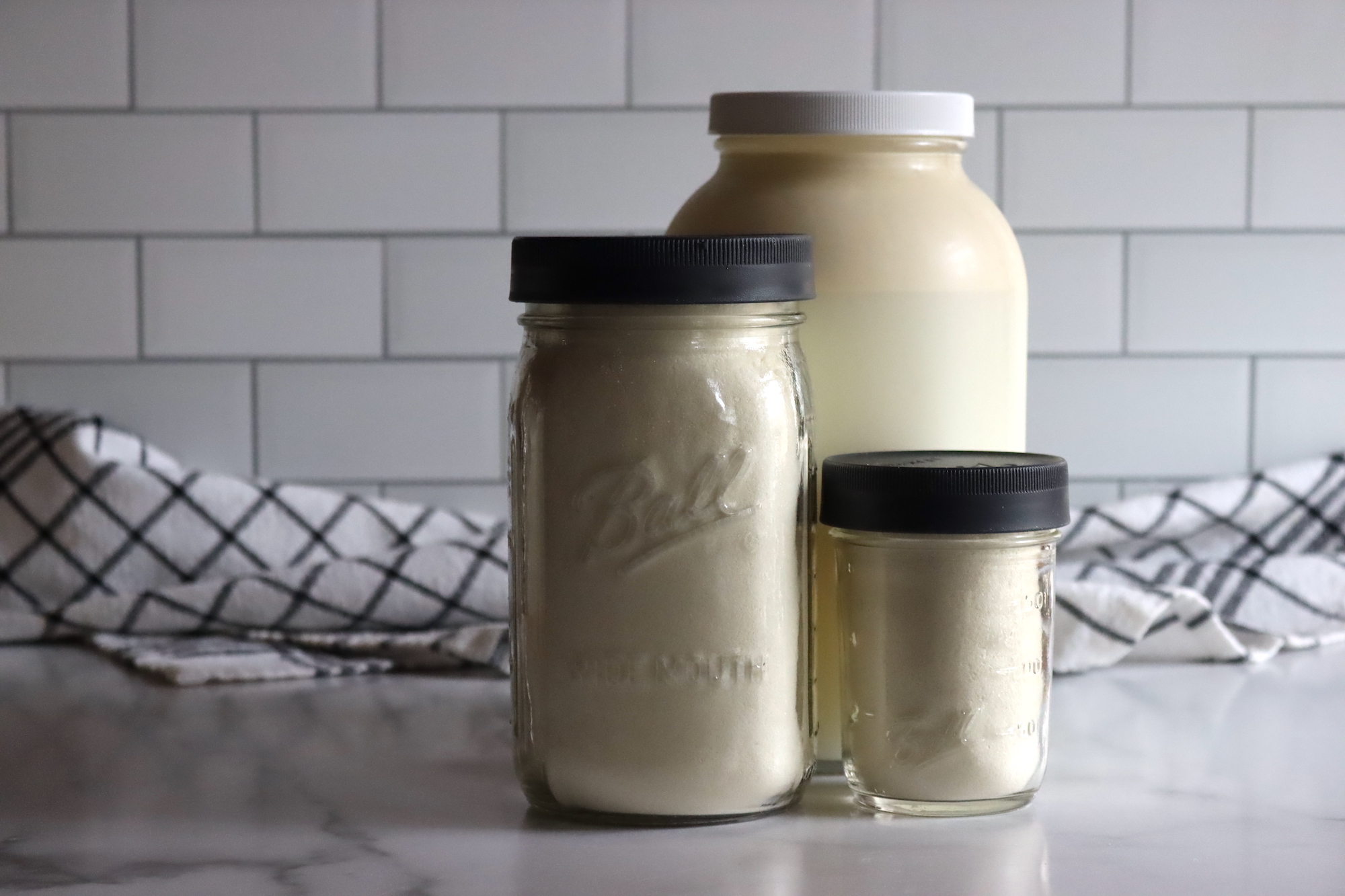
In the past year that we’ve had our home freeze dryer, I’ve tested out dozens of batches, and some worked out better than others. Freeze-dried milk, in particular, was incredibly popular with my family…especially my 5-year-old, who declared it “The Best Milk In the Whole World!”
I was skeptical, honestly, as I’ve tried dried milk…it’s not great, as anyone who grew up with bare pantry shelves drinking dried milk because it’s cheaper knows. And milk has just so darn much water in it, that it’s going to take forever in the freeze dryer.
We already make homemade cheese, yogurts, and half a dozen other preserved dairy products from scratch. Surely those must be better ways to preserve milk?
What I learned is that freeze-dried milk is nothing like dried milk. While the flavor (and consistency) of dried milk changes in the process, freeze-dried milk rehydrates back to exactly the same as before it was dried…and you can add a smidge extra powder into your glass to make it the best milk ever.
Homemade cheese is wonderful, but it won’t substitute for fresh milk in baking, and it certainly won’t fill the milk glass of your little one when you’ve run out of milk and the stores are closed.
While we don’t freeze-dry all our surplus milk, it certainly has its place, and now that I’ve tried it, freeze-dried milk will always have a place on my pantry shelf.
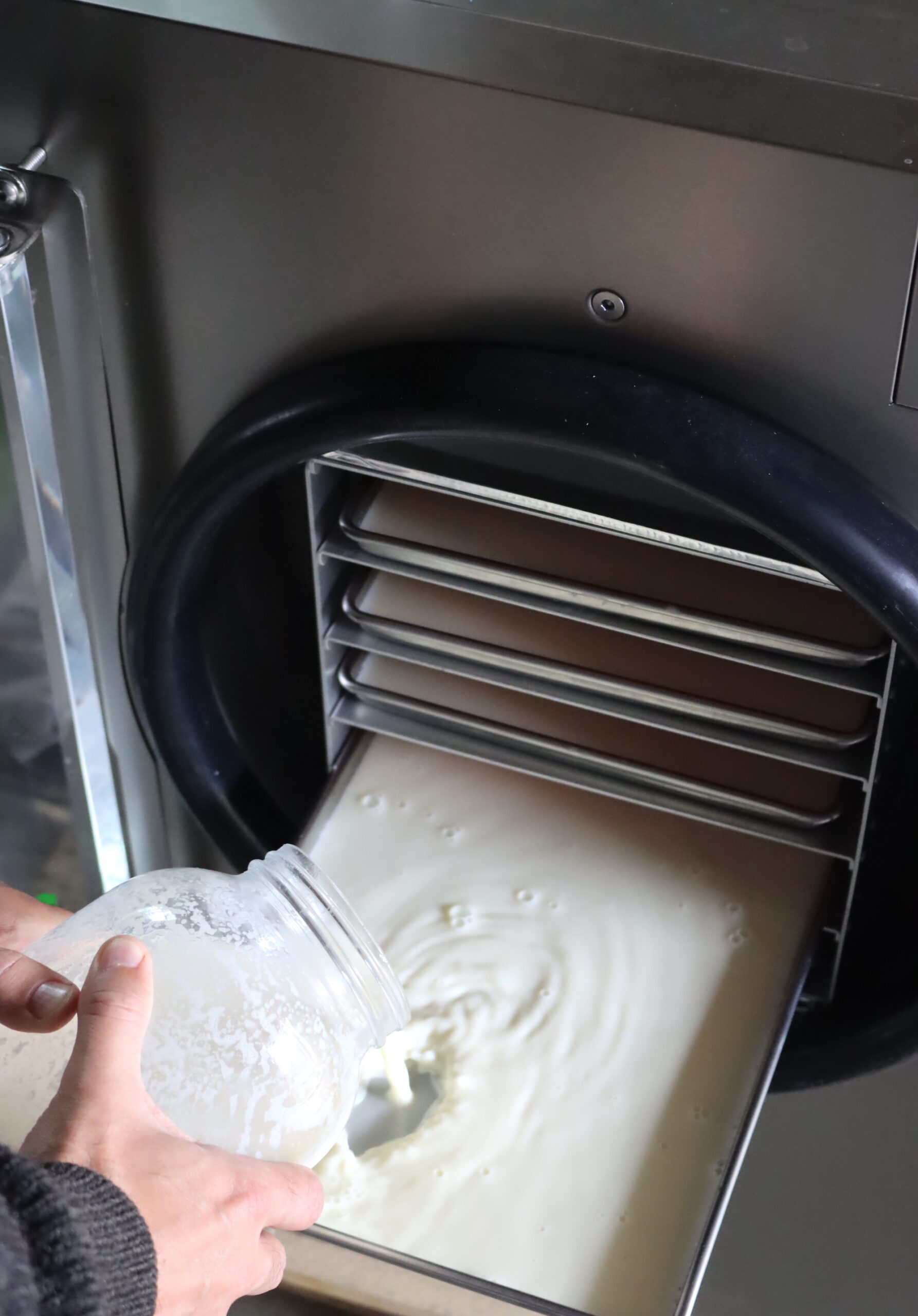
What’s The Difference Between Freeze Dried Milk and Powdered Milk?
Any kid that grew up knowing want knows the flavor of dried milk powder. It’s cheaper and easier to transport than fresh milk, so you can buy the powder by the pail full for much less money…only sacrificing taste.
Dried milk powder tastes…not great. If you make it double strength, and then coaks it to dissolve by using a blender, it’s tolerable. But it’s never good.
That’s because dried milk is flash-dried at high temperatures using an industrial process known as “spray drying,” since slow dehydrating perishable milk in a warm dehydrator would just lead to spoilage. That’s why it’s rare to see anything but dehydrated skim milk powder, as milk fat can’t handle that type of heat.
Freeze-dried milk, on the other hand, is made at very cold temperatures, and it maintains perfect fresh milk flavor.
When you put milk into a freeze dryer machine, the tray is first frozen and then dehydrated until it cracks apart into a crystalline powder that rehydrates easily in cold water. It’s not done commercially because, well, quite frankly, dehydrating milk is simply cheaper, and few people are buying dried milk for its incredible flavor.
But since it does rehydrate back into regular milk, I sincerely wish that a camping, food storage or preparedness company would try to make freeze-dried milk commercially available as a shelf-stable backup option…but until then, there’s the home freeze dryer.
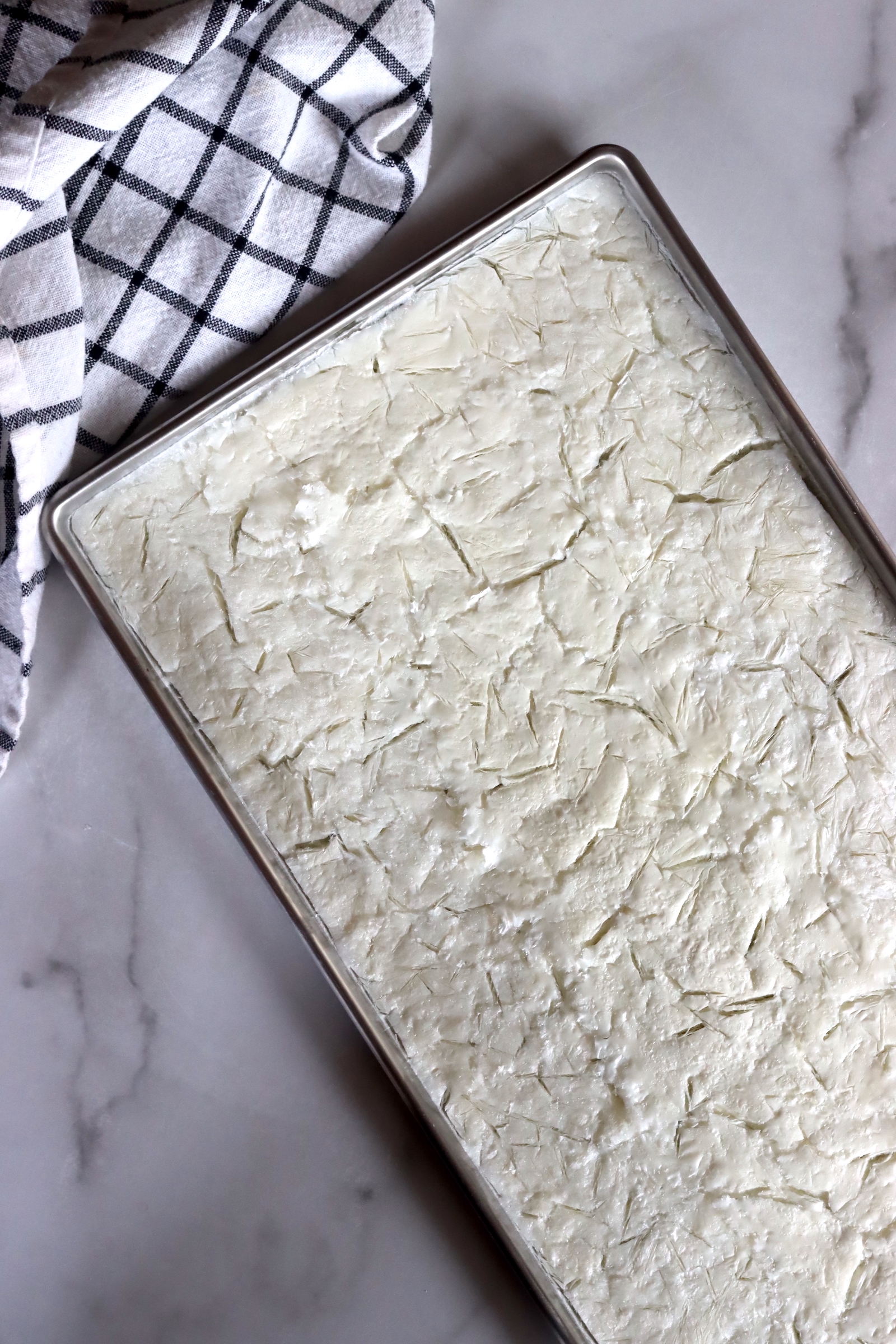
Best Milk to Freeze Dry
The best milk to freeze dry is the highest quality, best-tasting milk you can afford. Know that the milk will rehydrate to taste just as it did when it went into the freeze dryer, so whatever milk you normally drink will work wonderfully.
Keep in mind though, that the cost of making freeze-dried milk is mostly in the electricity and time it takes to run the freeze-dryer, not in buying the milk. If those costs are fixed, buying or sourcing really lovely milk only adds a small amount to the total cost.
I’d suggest avoiding ultra-pasteurized UHT milk, as that’s already treated to make it last a really long time…at the expense of flavor.
Regular pasteurized grocery store milk works just fine, though.
I’ve tested a number of different types of milk, from everyday grocery store pasteurized skim milk, all the way up to a high-fat raw whole milk from a Jersey cow, which produces more fat than other breeds. This is some of the creamiest cow milk you can get anywhere.
You can use:
- Raw Milk or Pasteurized
- Skim Milk or Whole Milk
- Homogenized or Cream Top
- Conventional or Organic or A2A Milk
The main thing to know is that if you do use raw milk, it is not pasteurized by this process. When you rehydrate it, it will have everything in it that it did when it went into the freeze dryer (for better or worse, depending on the source of your raw milk).
The same goes for conventional pasteurized, so don’t freeze dry milk that’s about to spoil or has been in the fridge too long.
You can also freeze dry other types of milk, including goat’s milk or sheep’s milk, and even human breast milk.

Freeze Dried Milk Yield
So, how much milk fits into a freeze-dryer unit? And how much space does that milk take up once powdered and dried?
I found that a standard one-gallon container of regular grocery store milk completely fills my large freeze-dryer trays. You have to pour the milk gently into the trays when they’re in the freeze dryer (as moving trays full of milk is a recipe for a mess).
The trays are filled about 2/3rds full, to allow for expansion during freezing.
Once fully dried, that gallon of whole milk yielded about 5 cups of freeze-dried whole milk. Mix that 5 cups back into water, and you’ll get a whole fresh gallon again.
When working with skim milk, you’re going to get a bit less, as skim milk has fewer milk solids and contains more water. With skim milk, a gallon of freeze-dried milk yields about 4 cups of dried freeze-dried milk powder.
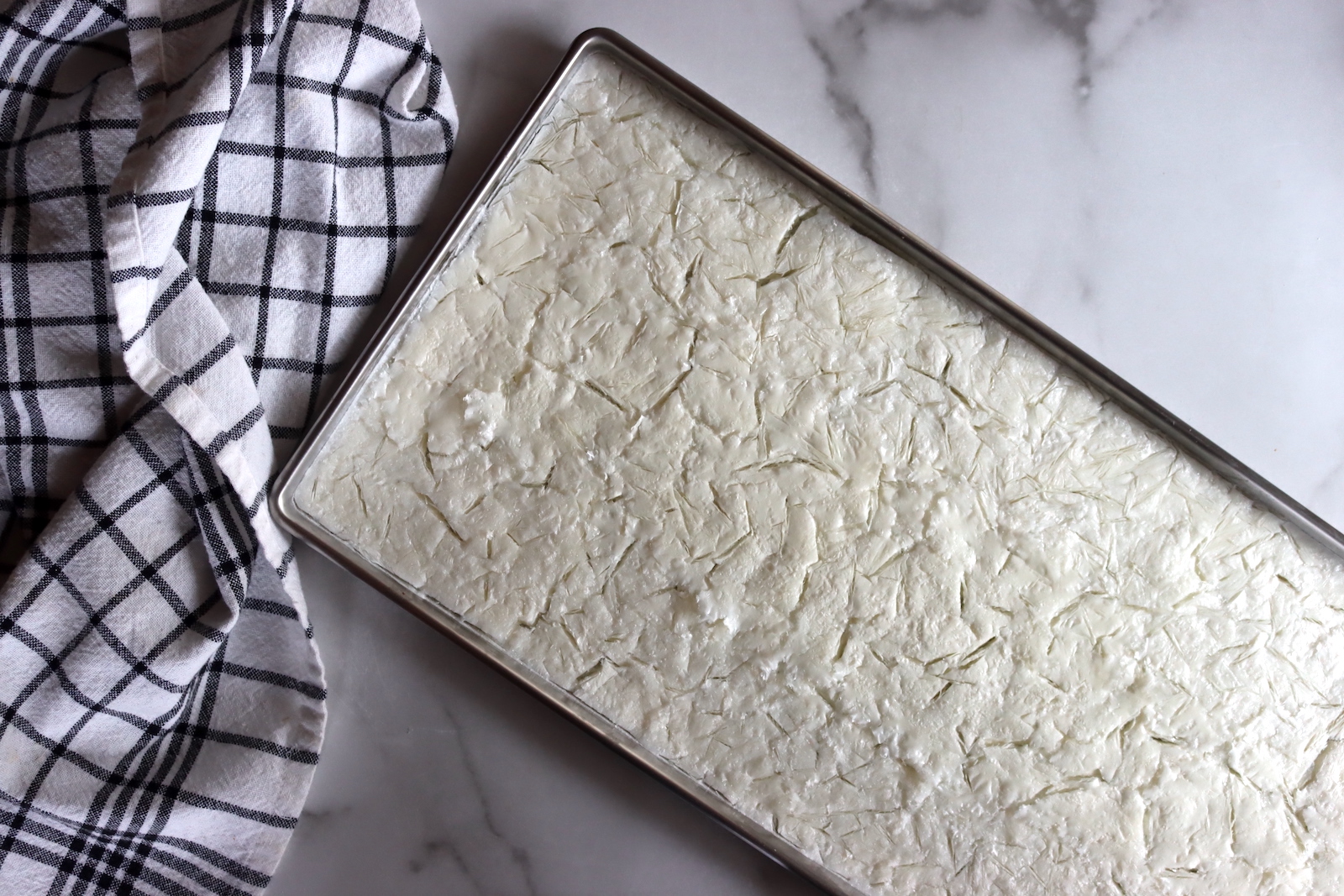
Freeze-dried milk comes off the trays as fluffy flakes, and it does take up much more volume initially. A food processor helps get it fine so that it’ll take up less space in storage.
But it also makes measuring freeze-dried milk by volume kind of tricky. For consistency, one cup of well-powdered freeze-dried milk weighs about 75 grams.
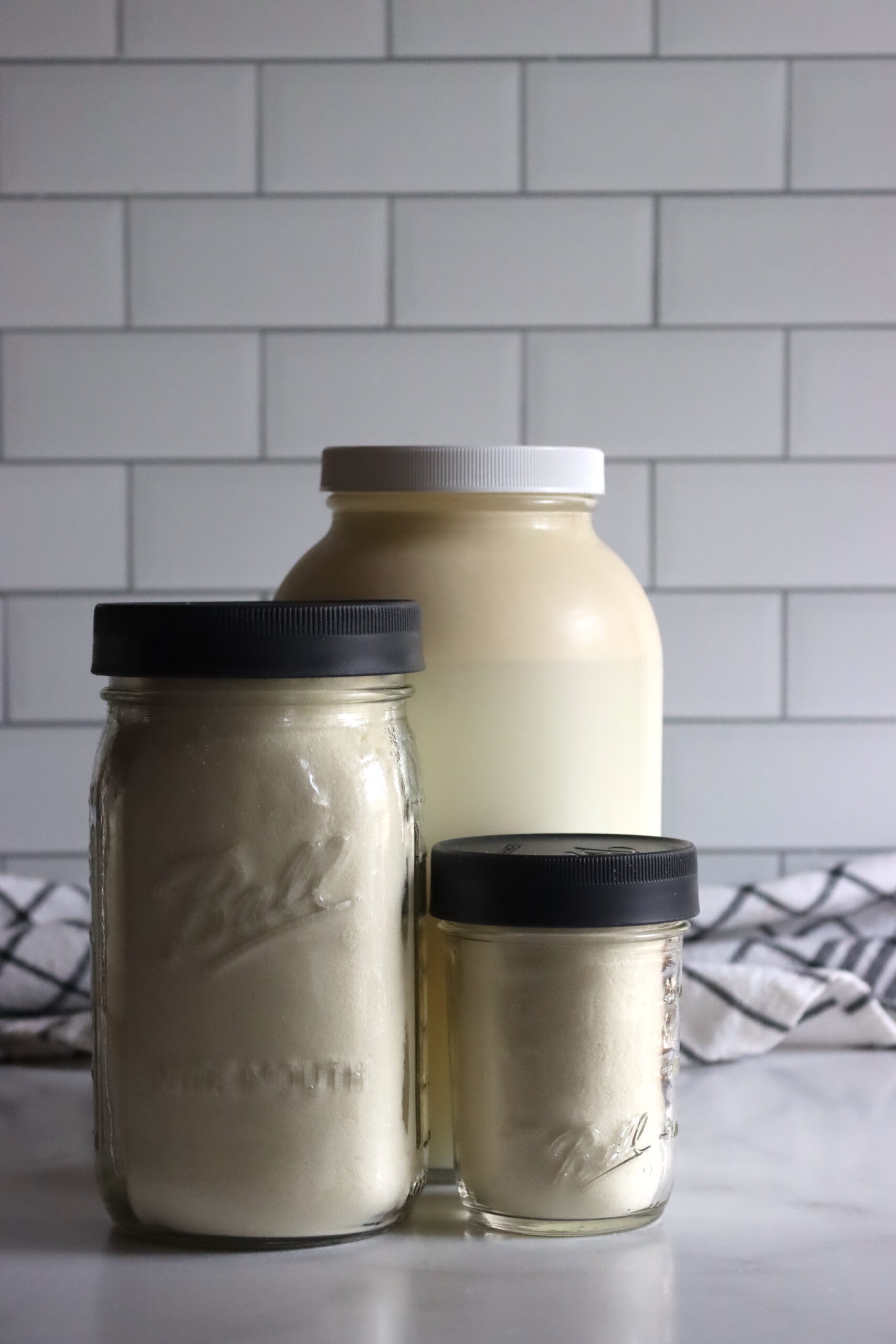
How to Freeze Dry Milk
Freeze-drying milk at home requires a home freeze dryer. You cannot accomplish this in a regular dehydrator or freezer.
Start by turning on your freeze dryer and pre-chilling it for at least 30 minutes, with the metal trays inserted.
If you’re working with fresh cow’s milk, you can choose to skim it and use the cream for another use, or leave it as whole milk.

Once the freeze dryer is pre-chilled with the metal trays inserted, gently pull the metal trays out slightly, one at a time. Pour the milk into each tray, filling them about 1/2 to 2/3rds full.
With a large freeze dryer, each tray will hold about 3 to 4 cups of milk, and there are five trays total.
Be extra careful not to spill as you’re pouring the milk into the trays.
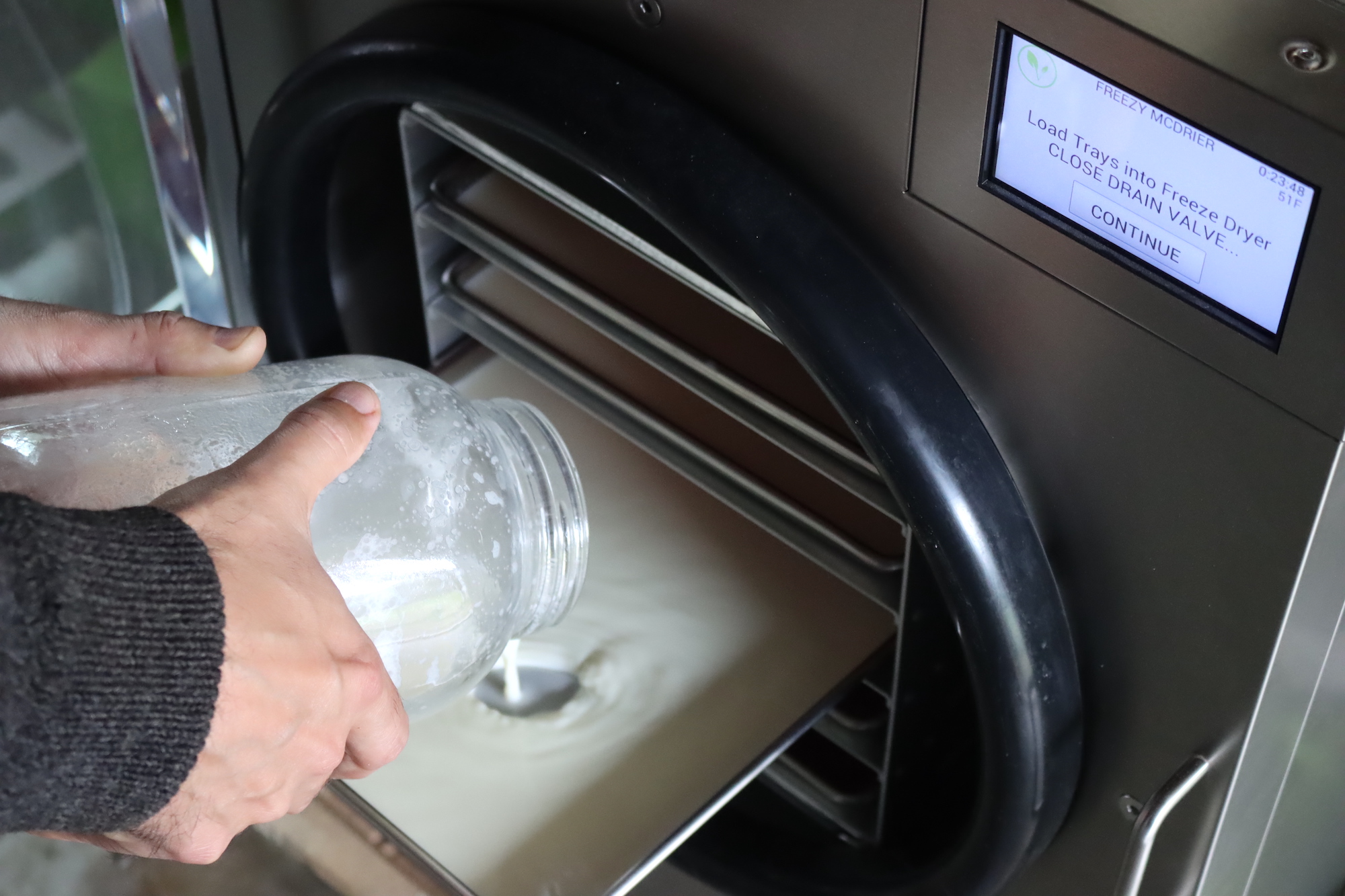
Harvest Right has a couple of silicone, non-stick tray options and liners, and they work really well for things like freeze-dried ice cream and freeze-dried eggs, but they were less helpful for freeze-dried milk.
I tried making a tray of freeze-dried milk using their silicone square tray, but it was a pain to get the milk cubes out and, honestly, much easier just to pour the milk onto the metal tray directly.
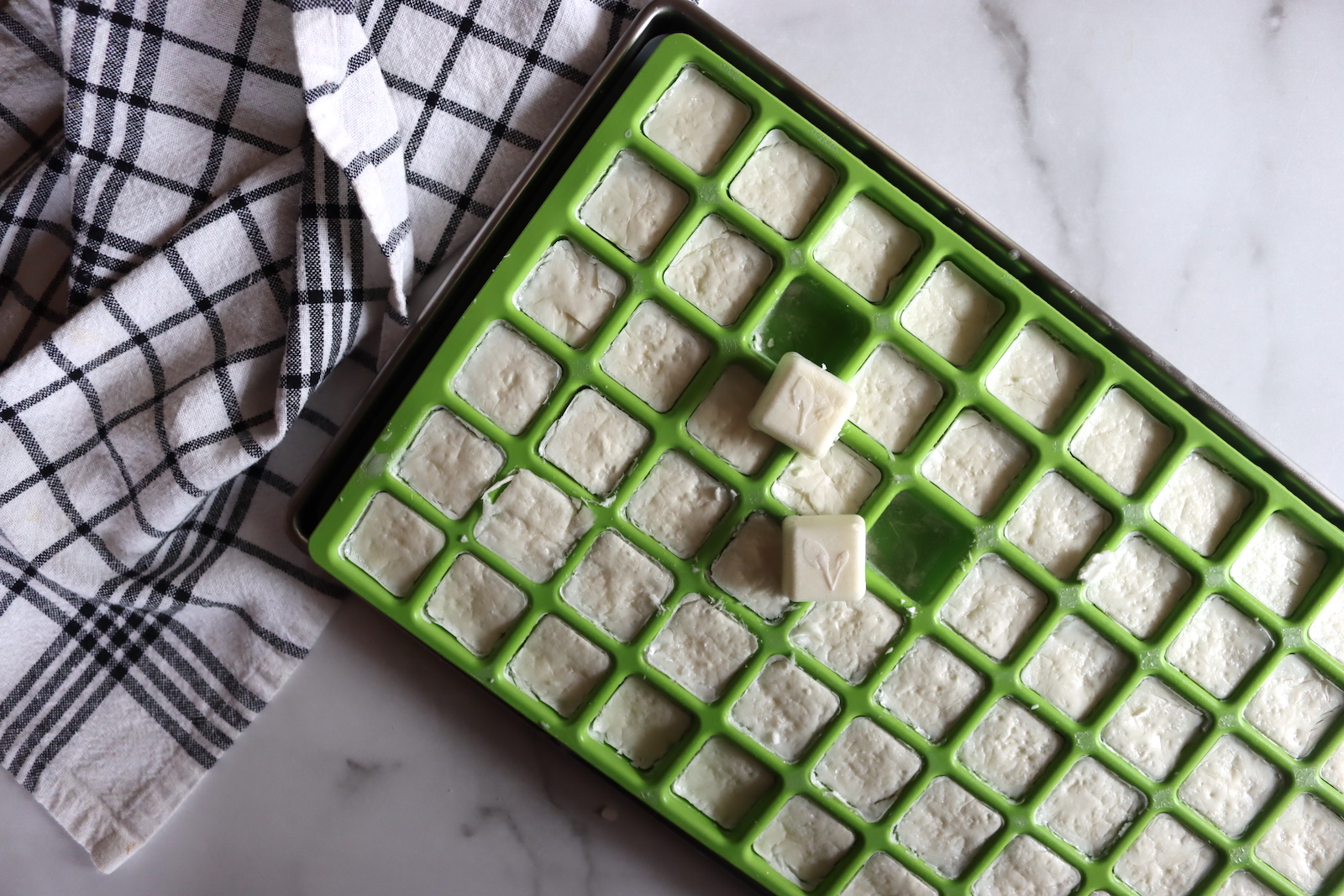
I also tried using their silicone tray liners on the freeze-dryer trays, and they just made a mess.
The milk seeps right under them, and then you have to get them out of it…and still get the milk off the tray. That’s no help.
Really, what worked the best was just pouring the milk directly onto the stainless steel freeze-dryer trays. Once it was freeze-dried, I used a spatula, and it came right off in sheets. The last little residue just rinsed off in the sink, so it is easy to clean up.
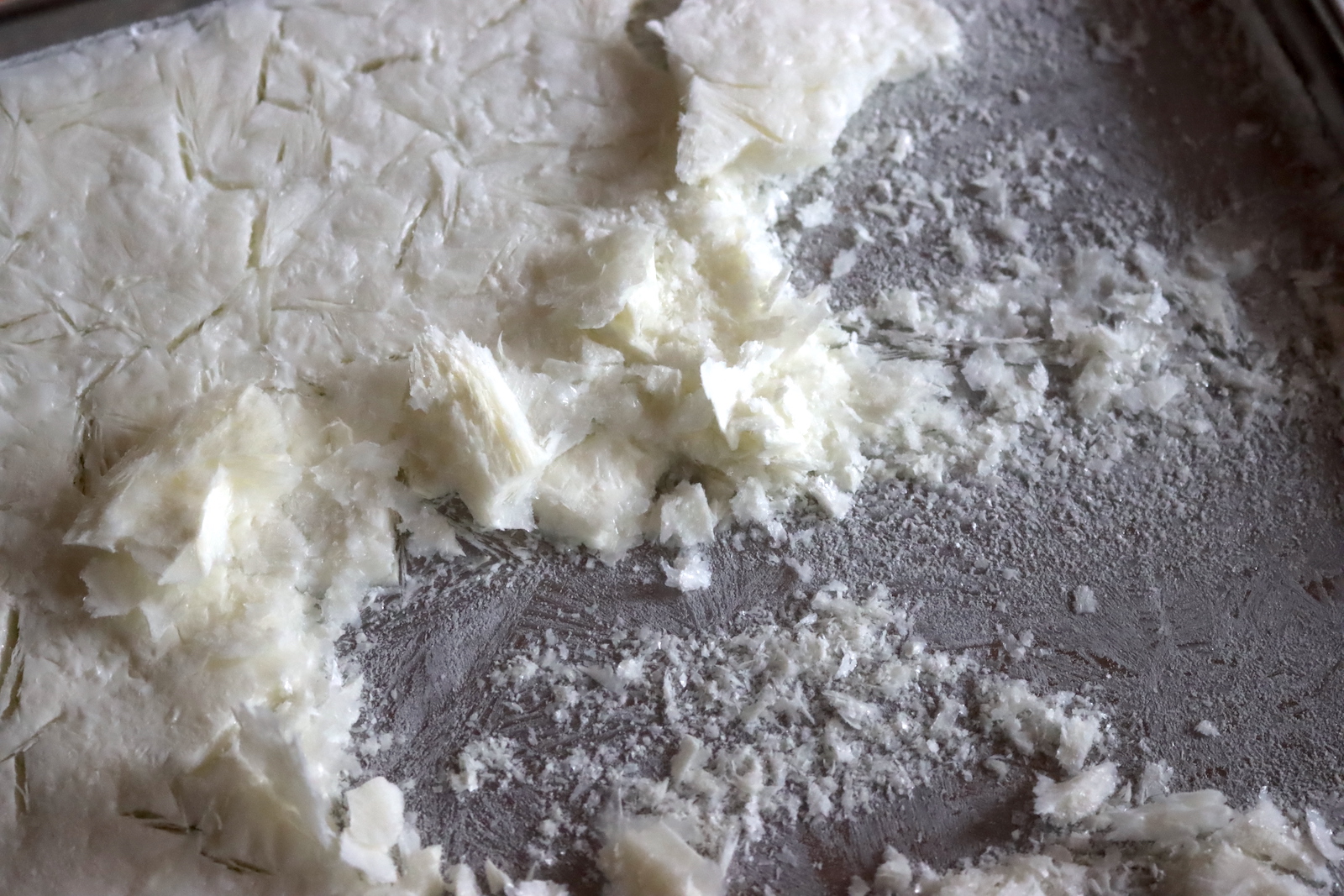
Once you’ve removed the freeze-dried milk from the trays, it’s oddly fluffy, kind of like cotton candy or mica crystals. That’s because all the milk solids are exactly where they were (and as they were) when you poured them onto the tray…the water’s just been removed.
Air is in place of that water, and if you want the freeze-dried milk to pack well into jars, you’ll need to crush it up or process it in a food processor.
A gallon of whole milk makes about a quart and a cup of freeze-dried milk powder (5 cups). If you’re using super whole milk with extra cream from a Jersey cow, it’ll make a bit more than that, about 5 1/2 cups. For skim milk, expect about a quart of freeze-dried milk powder from a gallon (4 cups).
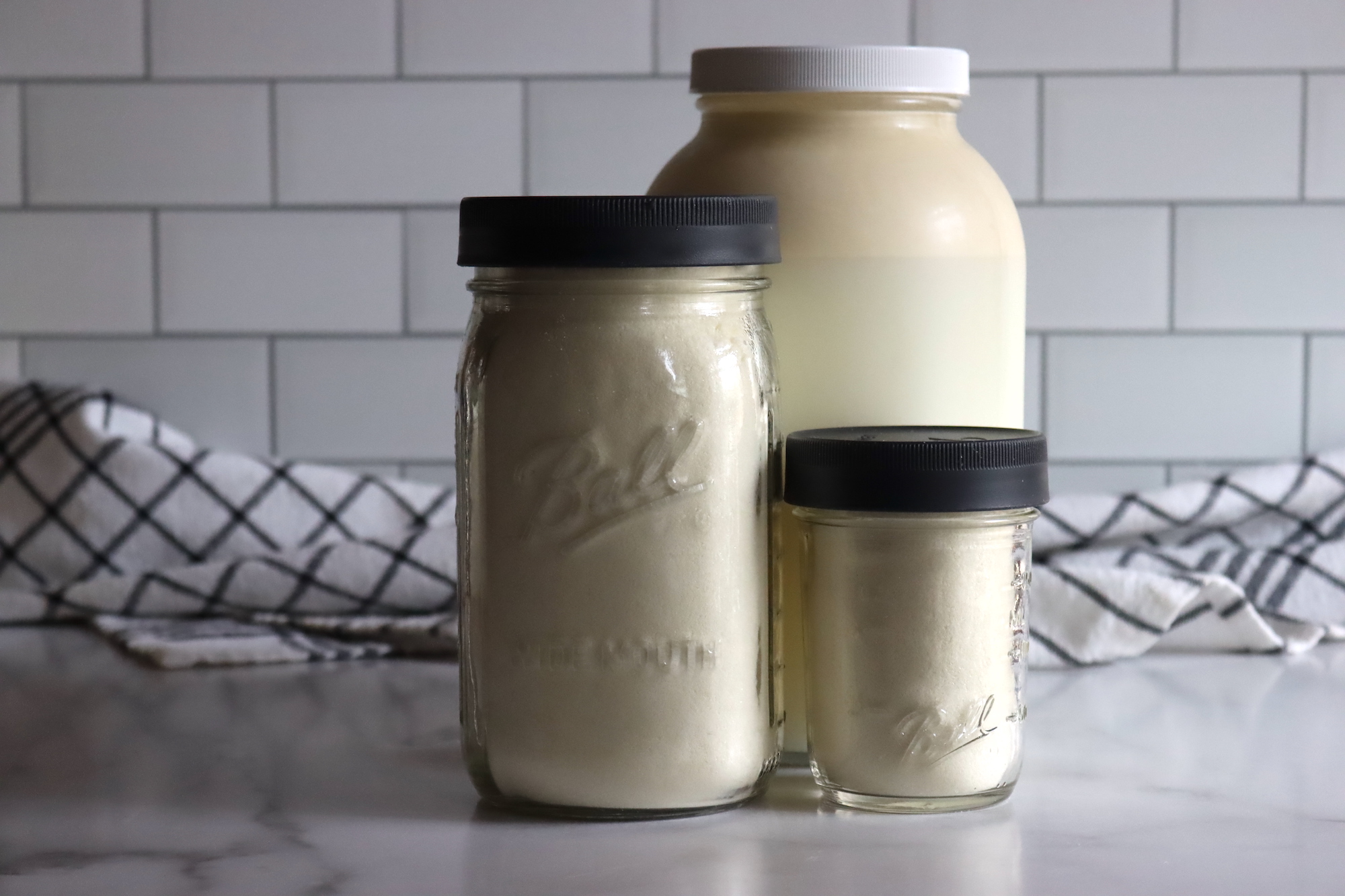
How Long Does it Take to Freeze Dry Milk?
So here’s the bad news…
Freeze-drying milk takes a long time, and as a result, uses quite a bit of electricity. This, quite frankly, is not a cost-effective way of preserving milk en-masse.
A gallon of milk took 30 hours to freeze dry in my large harvest right freeze dryer.
Making freeze-dried milk is not cheap, but it does give you something money can’t buy… shelf-stable milk with a 10+ year shelf life that tastes as fresh as the day it came from the cow. Not heated with an off flavor, like canned evaporated milk or conventional dehydrated milk powder.
If you have a homestead milk cow, which will produce between 3 and 10 gallons of milk a day, freeze-drying is not a practical or cost-effective way to preserve all that milk. You are going to need to use other more traditional methods, like cheese, butter and yogurt.
That said, freeze-drying milk is absolutely wonderful for the occasional gallon to squirrel away in the back pantry for a day when the cow’s not in milk…or you simply run out of milk and cant get to the grocery store.
Or, for the preparedness-minded, it will allow you to stock away a comfort food in your long-term storage pantry that money just can’t buy. If you’re preparing for an EMP or natural disaster that takes out electric power, this is a truly spectacular way to put up a small amount of emergency comfort food.
Being able to pull out a pouch of freeze-dried milk and rehydrate it with cool spring water for your grandbabies when all else in the world is falling apart is a pretty magical gift.
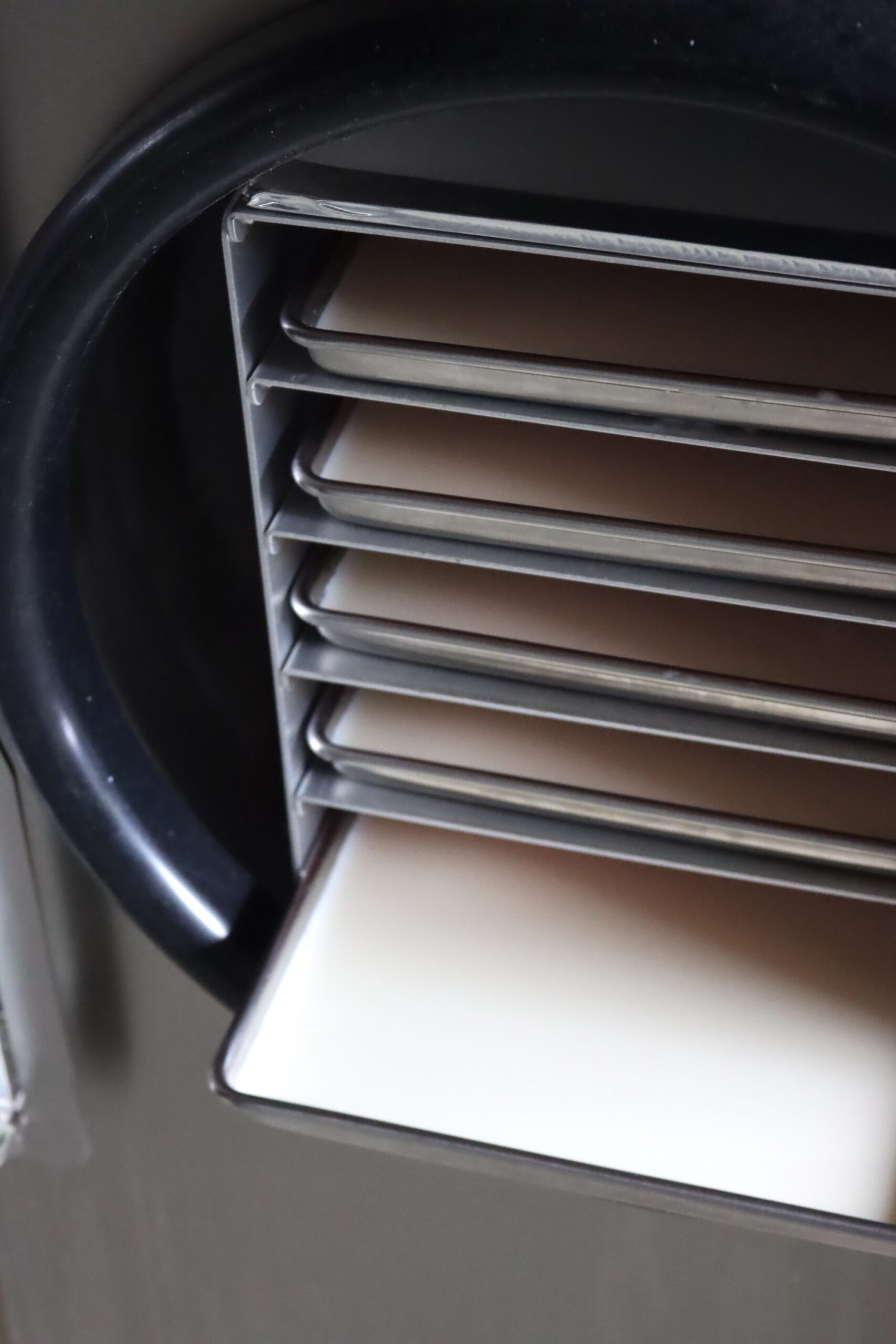
Reconstituting freeze-dried Milk
To reconstitute freeze-dried milk, add about 1 to 1 1/3 cup of milk powder (75 to 100 grams) to a quart mason jar and then fill the jar with cold water. Shake vigorously until dissolved, about 30 seconds.
Unlike conventional dried milk powder, which really doesn’t want to rehydrate, especially in cold water… freeze-dried milk powder rehydrates easily, and the consistency and flavor are exactly like fresh milk.
If you grew up on cheap dried milk, you probably know all the tricks…making it double strength, making it the night before and giving it all night to rehydrate in the fridge, or giving the jar to your little brother and making him shake it for half an hour…you know what I’m talking about.
None of that is necessary with freeze-dried milk powder.
Simply put it in the jar, add water, and shake.
Yes, it works perfectly well, even with ice-cold water.
You can also mix freeze-dried milk powder directly into beverages, like coffee or iced coffee. And it makes an excellent base for a hot cocoa mix.
How Does Freeze-Dried Milk Taste?
The taste of freeze-dried milk powder is the best part! It tastes exactly like regular milk, and however, the milk tasted before it went into the freeze dryer is how it will taste when it comes out (provided you rehydrate it back to its original consistency).
You can also rehydrate it to bonus strength by adding slightly more, which my kids call “super milk.”
Troubleshooting Freeze Dried Milk
If your freeze-dried milk has an off flavor, you might want to think back to what you dehydrated in the batch before the milk. Sometimes, flavors can linger in the freeze dryer if you don’t clean out the machine between each batch.
I found that out after I made a big batch of freeze-dried curry before a batch of fresh fruit…
But on the positive side, freeze-drying milk powder after a big batch of strawberries was absolutely magical. I’m now thinking I should make an intentional batch of freeze-dried strawberry milk powder when our homegrown strawberries come in next spring!
Other potential problems are all around spoilage, and if the milk doesn’t fully freeze dry, it will spoil in storage. Make sure it’s completely dry before you take it out of the freeze dryer, and if it’s not, add extra dry time.
Remember that freeze-drying does not kill natural bacteria or enzymes in the milk, so be sure your milk is clean and as fresh as possible. The clock stops while the milk is dried, but once it’s rehydrated, it has as much time as it did before it was freeze-dried. If it was about to spoil before it went into the machine, it would spoil quickly when rehydrated, but if it was fresh, it will keep quite a while in the fridge when re-constituted.
Freeze Dried Non-Dairy Milk
Next, I’m going to look into freeze-drying a few types of non-dairy milk to make almond milk powder and oat milk powder. I’m all about dairy myself, but I know plenty of people have dietary restrictions and preferences that don’t allow for real cow’s milk.
It’d be nice to have a shelf-stable option on hand for emergencies to bulk out your emergency food stores.
I have not tested these options yet, but they’re next on my list!
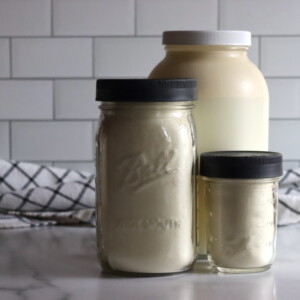
How to Freeze Dry Milk
Ingredients
- Milk
Instructions
- Start by pre-chilling your freeze dryer, with the metal trays inside, for at least 30 minutes.
- Carefully pull each metal tray out about 1/3 of the way, one at a time. Pour 3-4 cups of milk into each tray, filling it about 2/3rds of the way to the top, leaving room for expansion when the milk freezes. (Small and medium freeze dryer trays will hold less.)
- Make sure all the trays are back in the machine, close the door, and turn the machine on for a full freeze-dryer cycle. It should take about 30 hours to complete, but will vary based on outside humidity and temperature.
- When the cycle is complete, open the machine and check to make sure the milk is completely dried. If not dry, add a few hours extra dry time. If dry, remove the trays from the machine and pack for storage.
- Set the machine to defrost and allow it to defrost as you store the freeze-dried milk powder.
- For long-term storage, freeze-dried milk should be stored in mylar pouches with oxygen absorbers. If properly stored, it should keep for 10+ years. For short-term storage of 1 year or less, a mason jar with a tight sealing lid will work just fine. Refrigerate the milk once rehydrated.
- To rehydrate the milk, place 1 to 1 1/3 cup of freeze-dried milk powder (75 to 100 g) into a quart jar. Fill the jar with cold water and shake for about 30 seconds to dissolve the powder. Enjoy immediately, or store in the refrigerator.
Freeze Drying Guides
Looking for more ways to use your home freeze dryer?
- Home Freeze Drying for Beginners
- Best Freeze Dried Food for Long Term Storage
- Cooking with Freeze Dried Meat
- Freeze Dried Eggs
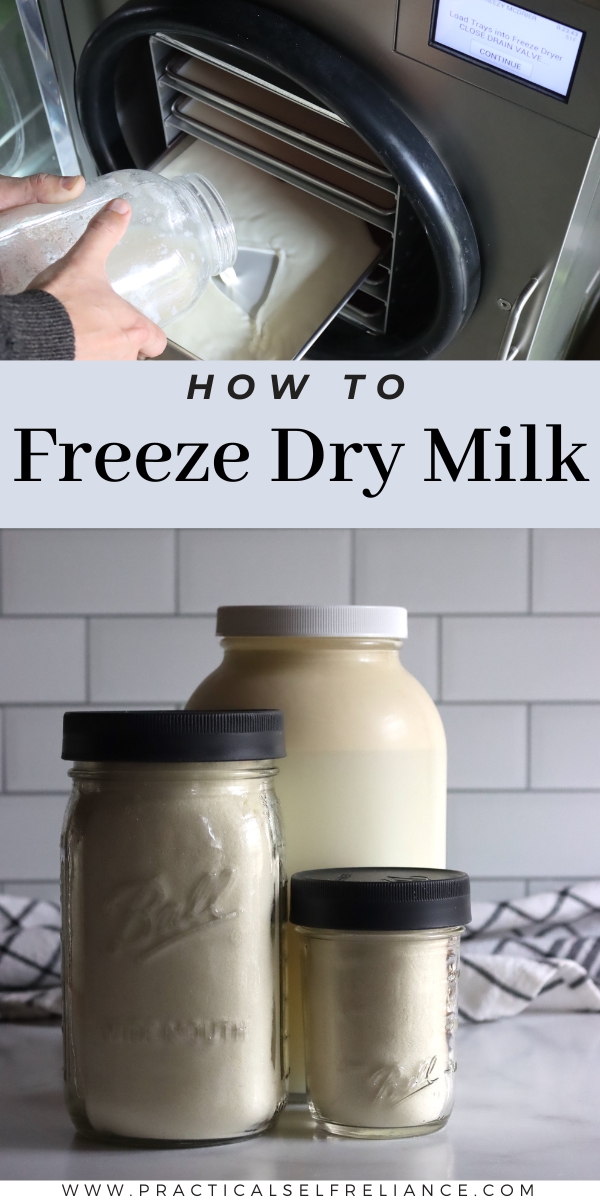
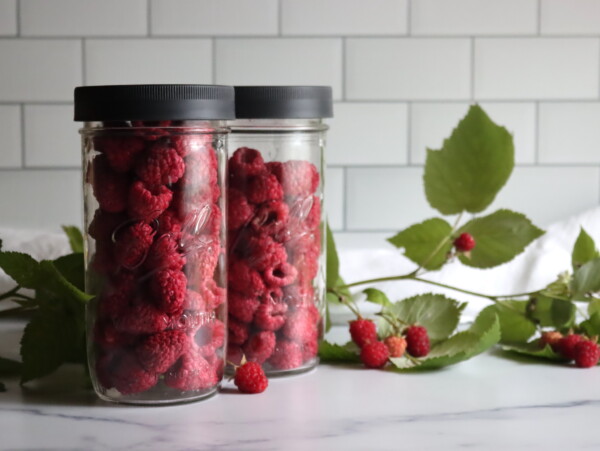
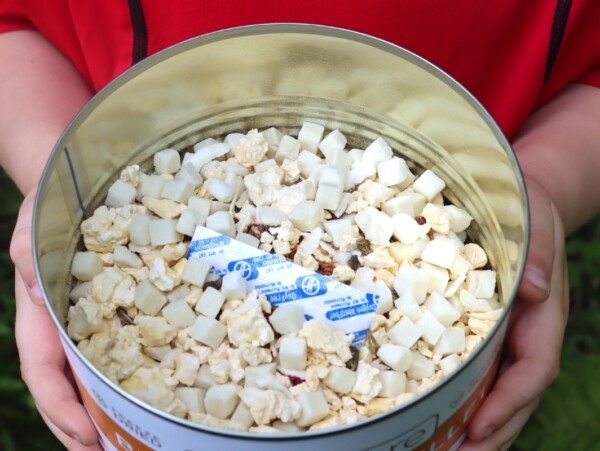
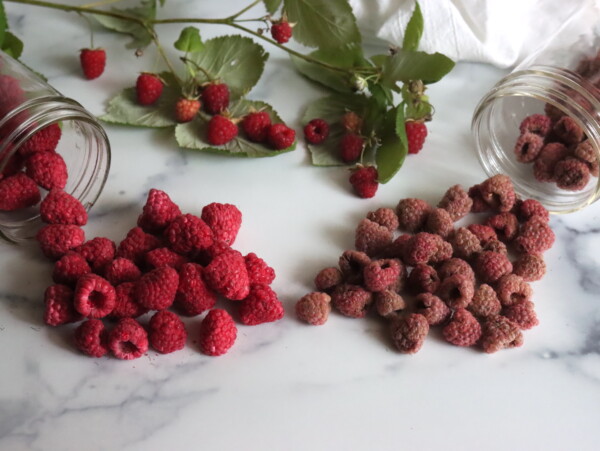
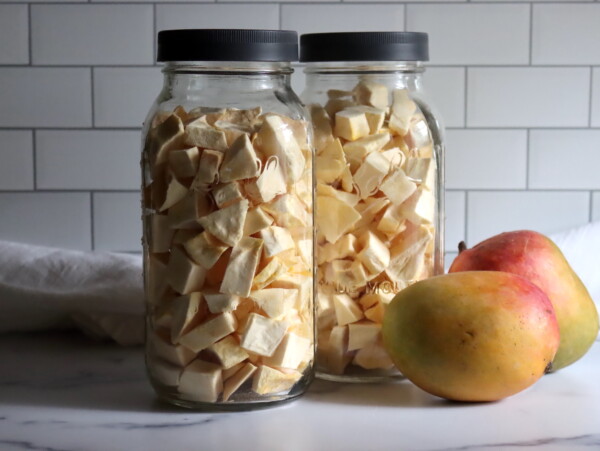










Could you use this reconstituted milk for yogurt or cheese?
Yes, you can! The reconstituted milk works just fine for both. And, if you reconstitute it a bit stronger than normal with less water, it makes a thicker yogurt.
We freeze dry 2% milk and when rehydrated it taste like the powdered milk you buy in the store, with that awful taste.
Would you happen to know if reconstituted FD raw milk has the natural probiotics or any other nutritional components changed by the FD process? Also, can it be used to make aged hard cheeses? I know regular freezing damages the proteins so the curds are too soft to make aged hard cheeses; and often frozen milk will separate a little to a lot upon thawing, leaving milk solids settling to the bottom of the jar.
I can’t seem to find any information on using freeze dried milk for cheese making. This may be something that you would need to experiment with. I did find some information on dried milk powder on the New England Cheesemaking Supply Company website. This could apply to freeze dried milk as well but I’m not sure. Here is what they say. “There are two kinds of powdered milk, nonfat and whole, both cab be used to make cheese. However, we recommend using whole dry milk powder for yogurt and soft cheese only. If used for aged cheese, it may taste rancid.” I’m not sure about the nutritional value of the raw milk after freeze drying either. I tried to do a little digging on it but I haven’t found anything definitive. I would love to know if you find any information on this.
I guess I’ll experiment and find out! I’m only just starting to get extra milk so it might be a month or two.
That sounds like a great plan and please come back and update us with your results.
What temperature did you use for freeze drying milk? Just wondering if the lower temperature would retain more of the nutrients?
Freeze drying preserves food nutrients better than other forms of preservation. You should be able just use the standard machine settings.
Im looking into buying a freeze dryer, $4000 is lots of money.
How much does your power bill go up when using your dryer?
I live in Canada where everything is so expensive. I just want it to be worth it.
According to Harvest Right, the freeze dryer will cost approximately $1.25-$2.80 per day depending on power costs in your area.
Pre-freeze? I’m new to all of this and still looking into it. Would pre-freezing the milk in baggies in the freezer reduce the freeze-dryer time and eliminate the potential spillage of pouring directly on the trays? I’m a newbie still looking into buying a freeze dryer and DEVOURING content where I can find it. Thanks for the in depth discussion and the simple instruction breakdown at the end is a great way to make sure we picked up on the important points throughout. Loved it and will be checking out more of your content.
I haven’t personally tried it but you can pre-freeze it in the trays or ice cube trays before freeze drying and it is supposed to make a more uniform freeze dry because the ice crystals are smaller and more uniform in size.
why wont anyone tell me the temperatures needed? Is it that big of a secret? I adjusted my machine for some skittles and now I dont know the original settings. I tried one batch and it exploded.
You can probably contact the manufacturer if you are needing information on the original settings of your machine.
To preserve enzymes or medicinal compounds in something, I generally stick to setting the temperature at 95 degrees Fahrenheit.
I’ve had my freeze dryer for three years now, using it very regularly and have been pleased with most foods. However, milk was not one of those items. Hubby and five kids and all milk lovers, did not love freeze dried milk. Honestly, it wasn’t that much better than regular powdered milk, and so not worth the time, effort, and expense. I highly recommend trying it out yourself before doing a lot of it.